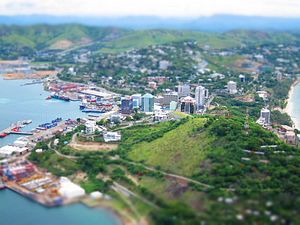Australia’s once secure sphere of influence in the South Pacific is coming under increasing threat from expanding Chinese activity in the region. In particular China is showing a strong desire to engage in a number of projects and partnerships within Papua New Guinea (PNG), a country that Australia has maintained a dominant influence over since it granted its independence in 1975.
Despite Australia’s belief that PNG is a strategic part of its “backyard,” it is only natural that as PNG develops greater economic capabilities it will undoubtedly seek a wider range of strategic partners of its own. Presently there are a number of large natural resource projects in the country — including the US$19 billion Exxon-Mobil liquid natural gas (LNG) project — that if managed well could lead to the country toward being less reliant on Australian aid and investment. Alongside projects such as this, PNG’s desire to join ASEAN would signal another shift away from Australia if its application were successful. Yet it is the influence of China’s expanding reach that is the greatest concern for Australian policymakers.
Chinese interest in PNG has increased dramatically since 1999 when the then-PNG government chose to switch its recognition of Chinese sovereignty from Beijing to Taipei. Although this recognition of Taiwan only lasted a week, it piqued a greater desire to engage within the country from the Beijing, and could be seen a cunning move by PNG in playing the Chinese recognition wars, enabling it to gain a greater interest and investment from the People’s Republic (PRC).
Since then trade between the two countries has grown to around $3.3 billion a year, with PNG becoming the largest exporter of timber to China. The Chinese also import a significant amount of LNG from the country, with further LNG projects backed by Chinese investment planned. The state-owned Metallurgical Corporation of China also has an 85 percent share in the Ramu Nickel Mine, and the $260 million Edevu Hydro Project is also being funded by the Chinese Development Bank.
The Chinese government has provided the PNG government with significant loans to construct roads and urban infrastructure in the capital Port Moresby, to create a high-speed broadband network, and also to create a national identity card system. Alongside this Chinese state-owned companies have been redeveloping the port at Lae, PNG’s second largest city, and constructing roads to Lae’s airport and from the city up into the mountainous highlands.
Despite these much needed improvements in the country’s infrastructure, the cost of servicing and repaying PNG’s debts to China has now risen from an annual sum of US $1.9 million five years ago, to US $20.1 million this year. These growing figures are beginning to look troubling to the PNG government, especially as this week both the Parliament building and the Governor-General’s residence had their electricity disconnected due to over US $300,000 in unpaid bills.
While Australia remains the biggest donor of aid to PNG — and has recently stated that it will provide an extra US $77 million to assist PNG with security for its hosting of the 2018 APEC leaders’ summit — these Chinese investments will no doubt be providing the Australian government some concern about whether Australia’s weight in the region will be able to continue to compete with China’s ever expanding reach. Last year’s PNG Supreme Court ruling that Australia’s asylum seeker detention facility on Manus Island was unconstitutional showed a willingness by PNG to push back against Australia. This remains an issue that may lead to a souring of relations between the two countries, should the United States not accept all of the refugees currently on Manus Island, and responsibility defaults back to Australia. Any tension between Australia and PNG risk moving PNG further towards China’s sphere of influence.
The Australian Defence department released a report in March 2015 that investigated the phenomenon of China’s increased influence in the broader South Pacific, and sought ways for Australia to maintain its status as the primary regional influence, in partnership with the United States as the region’s security hegemon. The report suggested that Chinese influence in the region may be about more than a desire to procure resources for its own development, and may also be an attempt to test its growing influence and ability to sideline regional powers such as Australia, Japan and the United States.
As the region’s largest economy outside of Australia and New Zealand, and a country that sits on the intersection between Southeast Asia and the South Pacific, PNG holds an important position for Australia’s ability to project power, and for its geographic strategic defence. Balancing these interests with the growing Chinese influence in PNG looks set to add an extra layer of complexity to its relationships with both PNG and China.

































